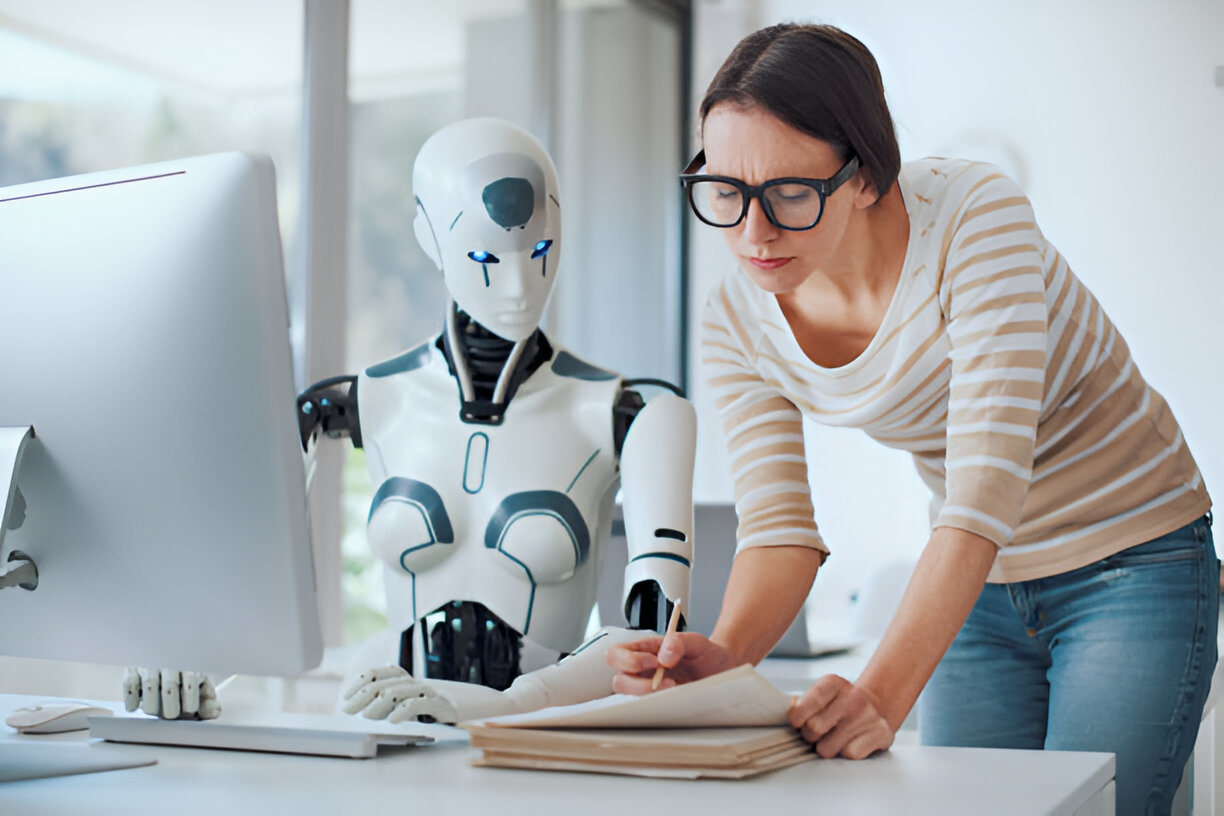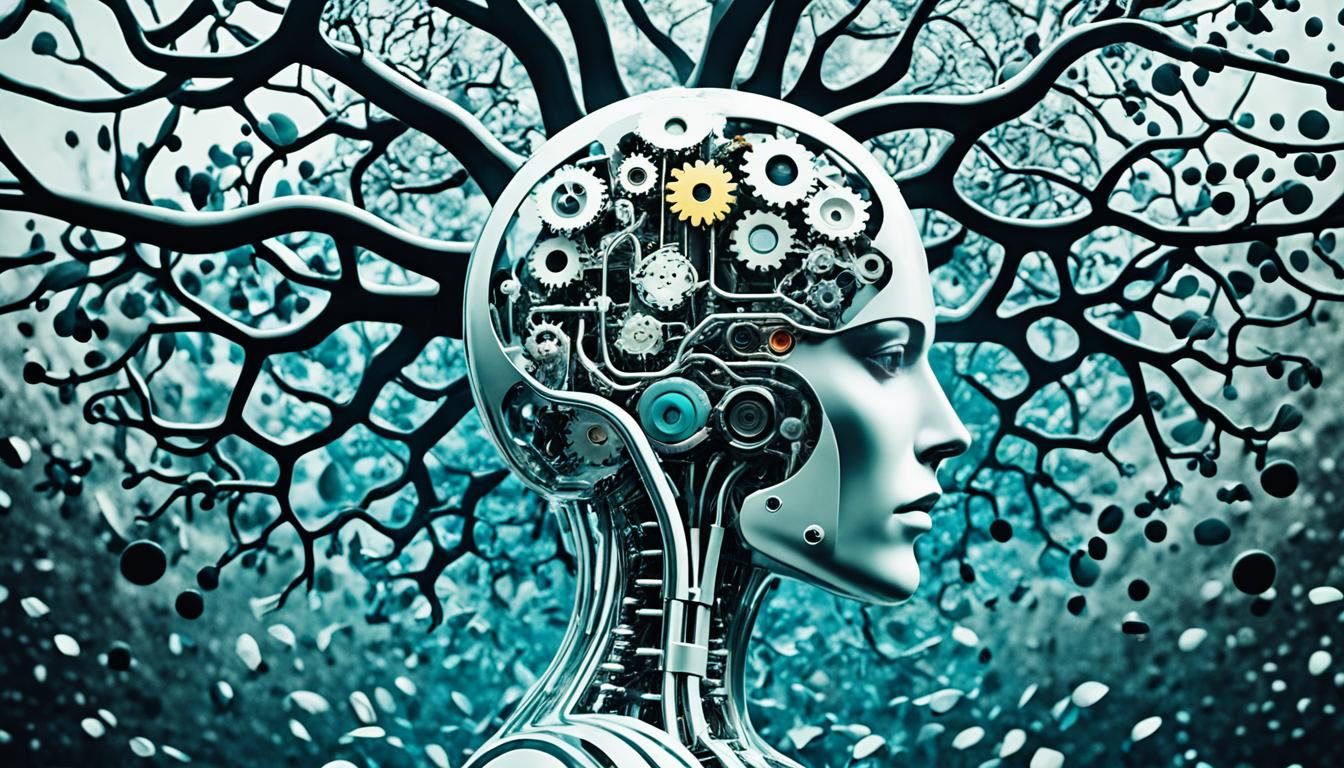Technology is changing fast, and one big question is: how does artificial intelligence (AI) work? AI is changing the game for businesses by doing things like thinking like humans and making quick decisions. But what makes it different from just automating tasks, and how can you use it to boost your marketing?
Key Takeaways
- AI technology is rapidly transforming the marketing industry, requiring companies to adapt their tech stack to remain competitive.
- AI can mimic human decision-making and respond in real-time, unlike traditional automation.
- AI involves machine learning, using data inputs to recognize patterns and improve its performance over time.
- Benefits of AI in marketing include reducing human error, enhancing research and data analysis, and automating repetitive tasks.
- AI can gather information and make predictions quickly, significantly reducing the time required for research tasks.
Exploring AI shows it’s not just a future idea but a powerful tool changing how businesses work. We’ll look at what AI is, how it works, and its big benefits for marketing. Get ready to see how AI can help you stay ahead!
What is AI and How is it Different from Automation?
Artificial intelligence (AI) and automation seem similar but are really different. Automation uses robots or software to follow set rules. This makes tasks more efficient and reduces mistakes. AI, on the other hand, uses complex algorithms to learn from data and make decisions like humans do.
Distinguishing Between AI and Automation
Automation and AI differ in how they work. Automation follows set rules to do tasks, while AI learns and adapts. AI can handle more tasks and adjust to new situations, making it more versatile.
Automation aims to make tasks more efficient by reducing manual work. AI, however, can bring about more changes by improving decision-making and customer experiences. For example, a 2023 survey showed that 36% of financial experts cut costs by over 10% with AI, and 46% saw better customer experiences.
AI’s ability to learn and adapt makes it stand out. It brings new levels of efficiency, productivity, and decision-making to various industries.
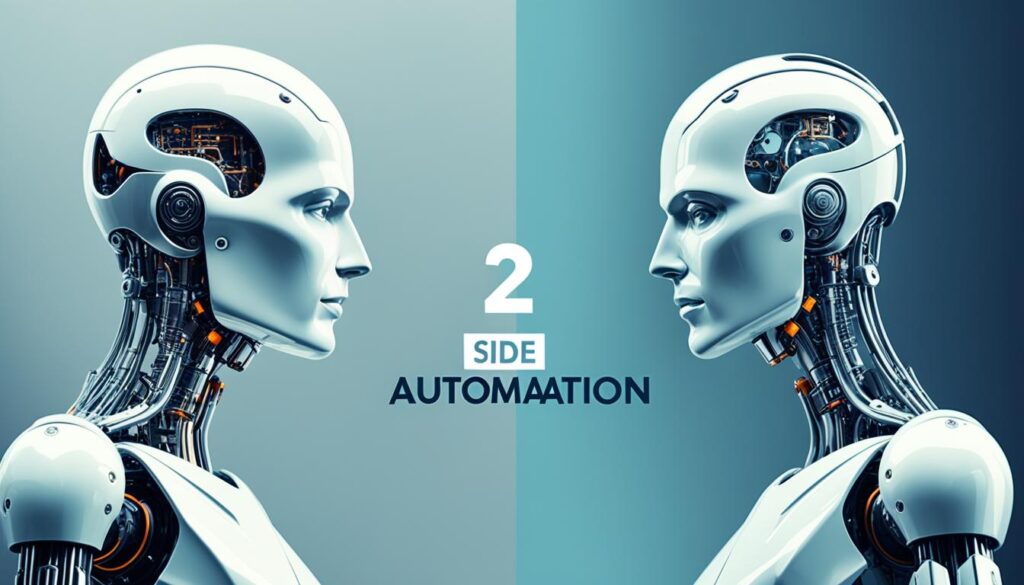
“The integration of artificial intelligence into automation is seen as moving towards hyperautomation, which is considered an unavoidable market state.”
Benefits of Using AI
Artificial Intelligence (AI) is changing the game in many industries. It brings big benefits that can change how businesses work and help make better decisions. Using AI can cut down on mistakes and make decisions smarter and fairer.
Reducing Human Error
One big plus of AI is its power to reduce human error. AI systems look at all possible outcomes and pick the best choice, avoiding human mistakes. They work with great precision, making tasks more accurate where humans might not.
Enhancing Research and Data Analysis
AI can quickly find information and make predictions, much faster than a human team. It uses data analysis to find insights and trends that might be missed by humans. This means businesses can make smart decisions faster, leading to more innovation and productivity.
Making Unbiased and Smart Decisions
With the right data inputs, AI can make decisions without bias, leading to unbiased and smart decisions. AI doesn’t let personal feelings or opinions cloud its judgment. This is very useful in areas like hiring, lending, and making policies.
The benefits of AI go way beyond these examples. It’s changing industries, making customers happier, and driving big advances in many areas. As AI keeps getting better, we’ll see more ways to use it for better efficiency, productivity, and decision-making.
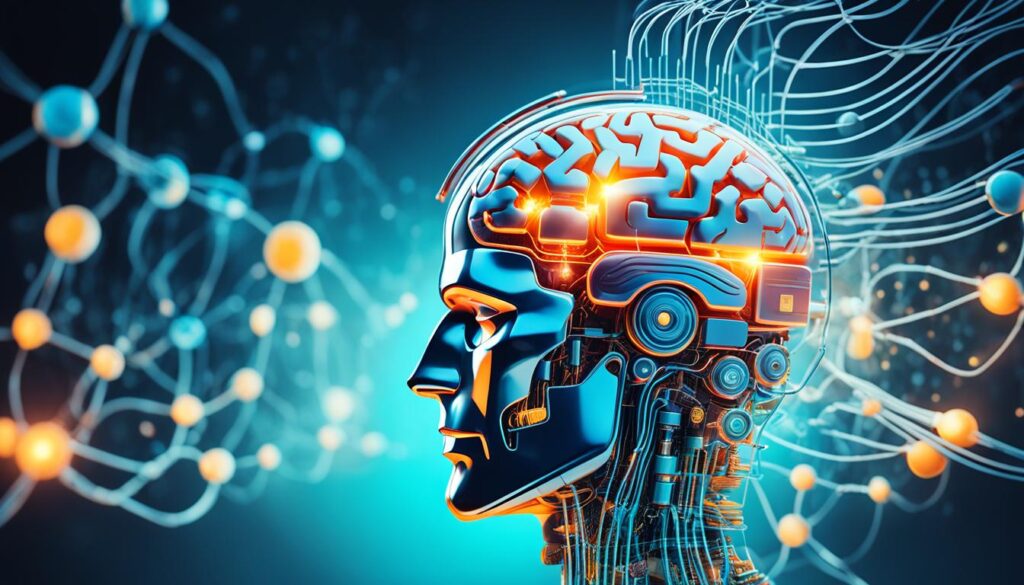
“AI is not just a tool, but a transformative technology that can enhance our lives and reshape the way we work, live, and interact with the world around us.”
How AI Works
In the world of technology, artificial intelligence (AI) is changing many areas of life. Ever wondered how this tech works? Let’s explore AI’s inner workings and see how it does amazing things.
AI combines big data with smart algorithms. These algorithms look for patterns, learn from data, and make decisions. AI isn’t just one algorithm. It’s a whole machine learning system that solves tough problems and offers solutions.
The main parts of AI are:
- Input: AI starts with data from sources like images, text, or sensor readings.
- Processing: The data is then worked on by AI algorithms. They find patterns and understand the info.
- Data Outcomes: The AI system makes predictions or decisions based on the data.
- Adjustments: The AI checks its results and tweaks its algorithms to get better through machine learning.
- Assessments: Finally, the AI checks how right its results are and keeps getting better over time.
This cycle of taking in data, processing it, making decisions, and adjusting is how AI keeps learning and getting better. This makes AI more accurate and useful over time.
“AI is not magic, it’s math.” – Masha Bell
AI is growing and being used in many areas, like healthcare, finance, and customer service. It uses machine learning and deep learning to help businesses make smarter choices. This makes operations more efficient and gives customers personalized experiences.
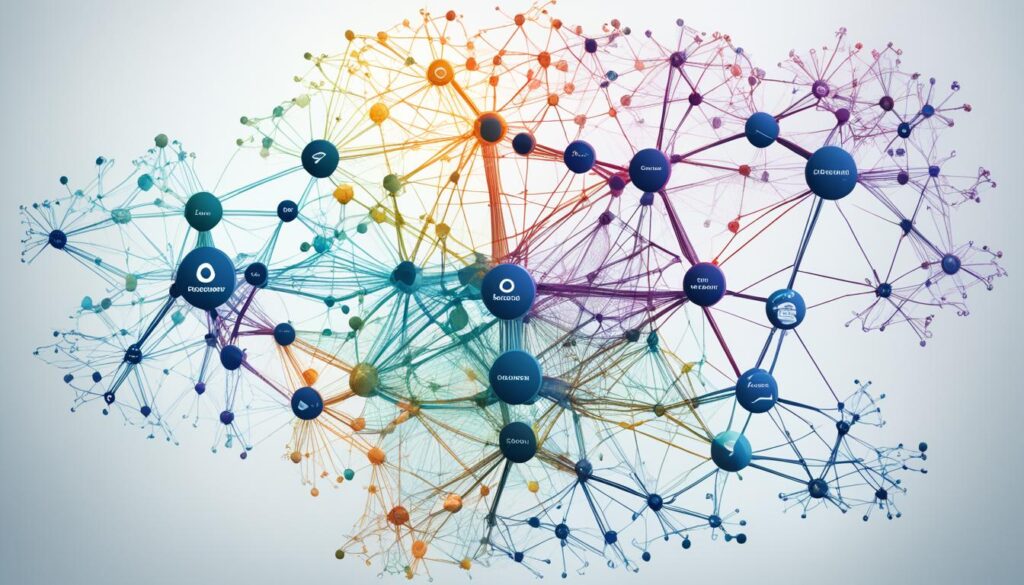
If you’re into tech or just curious about AI, knowing how it works can open your eyes to its power. It shows how AI is changing our world in big ways.
The Four Concepts of AI
In the world of artificial intelligence (AI), there are four main types that businesses need to know. These include reactive machines, limited memory AI, theory of mind, and self-aware AI. Each type has its own level of technology and uses, showing how AI is changing.
Reactive Machines
Reactive machines are the simplest kind of AI. They can only react to data right now and don’t remember anything. They’re great for tasks that need fast, simple answers, like playing chess or running machines.
IBM’s Deep Blue is a well-known example. It beat chess champion Garry Kasparov in 1997. This showed how well reactive machines can do in certain areas.
Limited Memory AI
Limited memory AI is more advanced than reactive machines. It can remember things to learn new tasks and make better choices. This kind of AI, like machine learning, is very common in businesses today.
For example, Netflix uses it to suggest movies based on what you’ve watched before. This shows how useful limited memory AI can be in real life.
This type of AI is always getting better. It can learn from new data or change based on how it’s used. This makes it good at solving complex problems in many industries.

As AI gets better, we’re looking at even more advanced ideas like theory of mind and self-aware AI. These ideas are still new but could change how AI interacts with us. They could make AI understand and share human feelings and thoughts, opening up new areas in AI research.
Modeling the World for AI
To teach AI to understand the world, we need to create a special space. This space, called “meal-space,” uses coordinates for each food or dish. These coordinates are based on how dishes are often found together in meals.
This helps the AI learn about food relationships. It can then suggest the best pairings for dishes.
Creating a Multi-Dimensional Space
Picture a huge space where every food or dish has its own set of coordinates. This space, “meal-space,” shows how dishes are often together in real meals. The closer two dishes are, the more they’re likely to be together.
By mapping the culinary world this way, AI can learn about food relationships. It can then suggest the best pairings that people like.
The Power of Co-Occurrence
The idea behind meal-space is co-occurrence. AI looks at lots of meal data to see which dishes often go together. This helps place each dish in the space, showing their relationships.
This method helps us understand how AI models learn. Just like dishes in meal-space, words have coordinates in a space. Their relationships come from how often they’re used together in text.
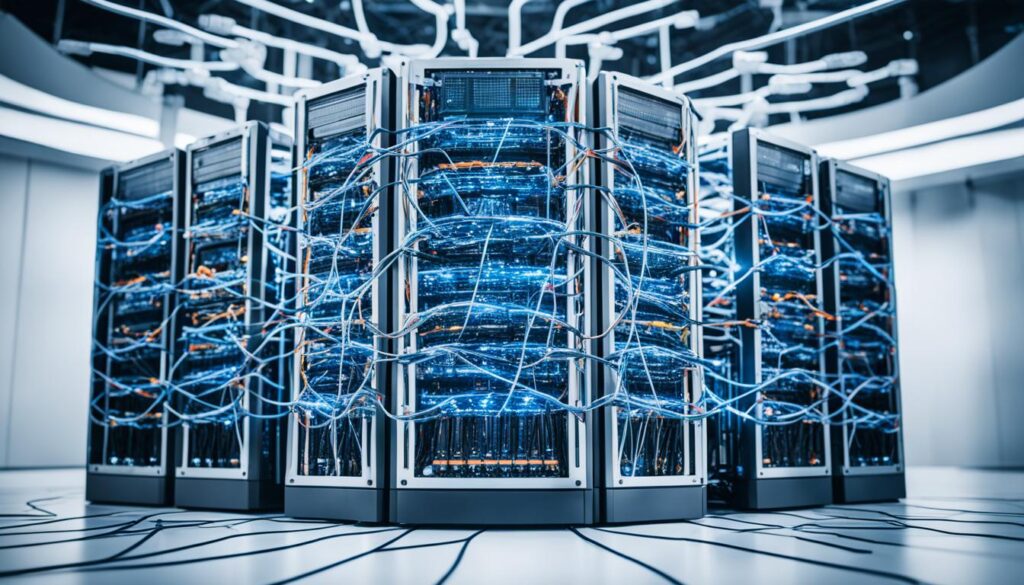
AI models learn by looking at lots of human-written content. They find patterns and predict what comes next in a sentence or between concepts. This lets AI do things like understand language better than humans.
Training AI Models
Training AI models is key to using this powerful technology. It’s like teaching the AI about the world by giving it lots of data. This lets it learn patterns and relationships in that data.
For instance, by showing an AI model how different dishes go together, it can learn about food connections. This lets it pick the best dish to add to a meal based on what’s already there.
The training of AI models has several important steps:
- Data Preparation: Collecting, cleaning, and getting the data ready for the model.
- Model Selection: Picking the right AI algorithm for the job.
- Initial Training: The model learns from the data in the first training phase.
- Validation and Refinement: Checking how well the model works and making it better.
This structured method helps train AI models to do tasks automatically, make better decisions, and find insights in data. The quality of the training data is key. It shapes what the AI can do.
| Key Steps in Training AI Models | Description |
|---|---|
| Data Preparation | Gathering, cleaning, and formatting the relevant data to be used for training the model. |
| Model Selection | Choosing the appropriate AI algorithm or architecture that best suits the specific problem or use case. |
| Initial Training | Running the model through an initial training phase, allowing it to learn from the provided data. |
| Validation and Refinement | Evaluating the model’s performance and iteratively adjusting the training process to improve its accuracy and reliability. |

Mastering AI model training opens up new possibilities. It can make operations smoother and reveal insights for business growth. As AI evolves, training these models will be crucial for staying ahead in tech innovation and competition.
How AI Works
Artificial Intelligence (AI) has changed the world, making big impacts on many areas of life. It’s a complex process that starts with collecting data and ends with making predictions. Let’s look at how AI works and its amazing abilities.
Input
The first step in AI is collecting data, known as the “input.” This data can be from many sources like sensors, images, text, or sounds. The quality and variety of this data are key for AI to learn and predict well.
Processing
After collecting data, AI starts processing it. Here, AI algorithms look for patterns and find important information. Machine learning and deep learning models use advanced methods like neural networks to recognize patterns and make choices.
Data Outcomes
The processing phase ends with data outcomes, which are the AI’s predictions or results. These can be anything from classifying data to making forecasts. The accuracy of these outcomes is vital for making good decisions.
Adjustments
Next, AI adjusts its results by comparing them to what was expected. This feedback loop helps AI learn from mistakes and get better over time. Continuous learning is key for AI to improve its accuracy and efficiency.
Assessments
The last step is assessing the AI’s performance. This helps us understand what the AI does well and what it needs to work on. The insights from these assessments help improve the AI’s data, algorithms, or design for the next cycle.
Understanding how AI works shows us its complexity and potential. As AI grows and gets better, it will play a big role in our future. It will solve complex problems and make our lives better in many ways.
Creating Basic AI for Business
Businesses don’t need complex AI systems to use this technology. AI can automate repetitive tasks, letting employees focus on important work. This includes building customer relationships or closing sales. Tasks in human resources, chatbots on websites, or AI content generation are good places to start. Just make sure the data is correct and unbiased.
Using pre-trained models is an easy way for businesses to use AI. Companies like Google offer these models that can be easily customized and used. This lets businesses add AI to their work quickly without needing a lot of technical knowledge or resources.
When making basic AI for business, think about feasibility, impact, data, privacy, relevance, scalability, cost, software compatibility, resources, speed, and interpretability. Make sure the AI fits your business goals and brings real benefits.
| Method | Accessibility | Customization | Ease of Use |
|---|---|---|---|
| No-code/Low-code Platforms | High | Medium | High |
| AutoML | Medium | High | Medium |
| Traditional Programming | Low | High | Low |
Businesses have many ways to build basic AI. No-code/low-code platforms make AI easy to develop without much coding. AutoML offers a middle ground between these and traditional programming. For those with deep tech skills, traditional programming lets you customize and use domain-specific knowledge.
It’s important for businesses to make AI models that are accurate, scalable, and adaptable. By using creating basic ai for business and ai in business, companies can improve efficiency, make better decisions, and stay ahead in their industries.
“AI is not a replacement for human intelligence, but rather a powerful tool that can augment and enhance it. When implemented strategically, AI can become a crucial component in a business’s digital transformation journey.”
Envisioning AI as Language Models
Exploring artificial intelligence (AI) shows us how ideas from the physical world can help with language. Just like we map out food in a multi-dimensional space, AI uses a similar idea for words. It treats words as points in a high-dimensional “vector space.”
This new way of understanding language lets AI systems do amazing things. They can create text that makes sense and is relevant. This is because they learn from a huge amount of text data.
Words as Coordinates in Vector Space
Picture a huge space where each word is a point, or vector. Words close together mean they’re related, like “dog” and “puppy.” Words far apart, like “dog” and “galaxy,” aren’t as connected.
This way of seeing language helps AI understand and play with language deeply. By doing math on these word vectors, AI can create new text. This text is meaningful and right, based on patterns in the data it learned from.
Big language models like GPT-4 have changed what AI can do with language. They can generate text, summarize, translate, and analyze feelings, all thanks to their deep language knowledge.
As AI grows, using words as vectors in a space will be key to the future of language. These models open up new ways to communicate, create, and solve problems. They change how we use technology and see the world.
Conclusion
In this article, we looked at how AI works and its differences from automation. We also talked about the benefits of using AI in business. We covered the basics of AI, how AI models are trained, and simple ways AI can help businesses.
Understanding AI’s basics helps businesses update their tech and workflows. This way, they can use AI’s power to lead in their fields.
Machine learning is getting better fast, and AI is being used more in fields like marketing, healthcare, and finance. This means there’s a big need for AI experts. Companies need to keep up with AI changes to stay ahead.
But, AI models are complex, and figuring out how they make decisions is tricky. This raises questions about their reliability and the need for clear explanations. The push for “the right to explanation” shows how important it is to understand AI’s decision-making.
By tackling these issues, businesses can gain trust, make better AI decisions, and fully benefit from this new technology.
FAQ
What is the difference between AI and automation?
Automation uses manual data to do tasks. AI, on the other hand, learns from data to make decisions. It can think like a human and make choices in real-time. This makes AI very useful for businesses.
What are the benefits of using AI in business?
AI cuts down on human mistakes. It quickly gathers info and makes predictions. It also removes bias in decision-making for smarter choices.
How does AI work?
AI combines big data with smart algorithms. It learns from the data to recognize patterns. It’s a complex system that can solve problems and suggest solutions.
What are the four main concepts of AI?
AI has four main concepts. Reactive machines just react to data. Limited memory technologies learn new tasks. Theory of mind and self-aware AI are the most advanced types used in business.
How do you model the world for AI?
We teach AI to understand the world by creating a special space. Each food type has its own set of coordinates. This helps the AI learn how foods relate to each other and suggest the best pairings.
How do you train AI models?
Training AI models is like teaching it about the world. We feed it data on how different foods are paired. This helps it learn patterns and suggest the best dish for a meal.
How does the step-by-step process of how AI works?
AI’s process includes input, processing, data outcomes, adjustments, and assessments. It starts with collecting data, then interprets it and recognizes patterns. It learns from mistakes and refines its algorithms before analyzing data and providing feedback.
How can businesses use basic AI solutions?
Businesses can use AI for simple tasks that take up too much time. This lets employees focus on important tasks like customer service or sales. They can automate HR tasks, use chatbots, or generate content with AI, as long as the data is accurate and unbiased.
How can AI be used in language models?
AI for language models uses the same ideas as modeling the world for AI. Words are like coordinates in a special space. This lets AI understand word relationships and generate text that makes sense based on the data it’s trained on.




